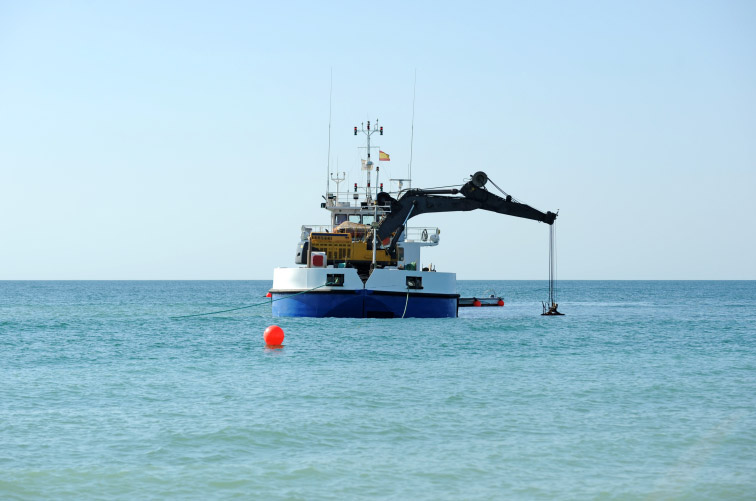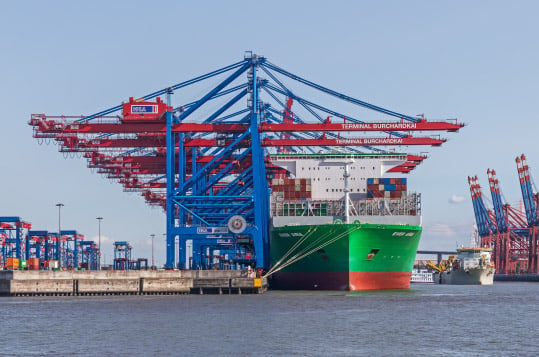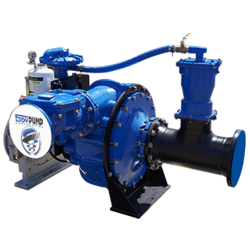Applications of EDDY Pump in the Navy



Applications of Our Slurry Pumps in the Navy

- Bilge Water Management: Our submersible pumps are vital in removing bilge water containing oil, sludge, and debris from the ship’s lower compartments, ensuring vessel stability and compliance with environmental regulations.
- Dewatering: The submersible pumps help dewater the naval bases. In case of flooding or water ingress, the submersible pumps are employed to rapidly remove water from compartments, helping to maintain the ship’s buoyancy, stability, and safety.
- Desilting and Dredging: Slurry pumps are used for desilting and dredging tasks in ports, harbors, naval bases, and channels to ensure the safe navigation of ships and submarines and prevent sediment buildup that could affect vessel operations.
- Fuel and Oil Transfer: Submersible pumps from EDDY Pump facilitate the transfer of power, oil, and other liquids between vessels, allowing for efficient refueling and resupply operations.
- Waste Water Handling or CHT: These submersible pumps help manage wastewater containing solids and contaminants generated on board, contributing to effective waste disposal and minimizing environmental impact.
- Emergency Response: Slurry pumps are crucial for naval bases in emergency scenarios, such as firefighting efforts where water needs to be pumped from various sources to control and extinguish fires on board.
- Cargo Handling: Submersible pumps aid in the loading and unloading of bulk materials, including ores, grains, and other particulate substances, during cargo operations around the naval bases.
- Underwater Construction: Our submersible pumps are utilized in underwater construction and repair projects, assisting in tasks like excavating trenches, laying pipelines, and placing underwater structures. This ensures the safe maneuvring of submarines and other vessels.
- Mine Countermeasures: Submersible pumps can aid in mine countermeasure operations by removing sediments and debris from areas where mines are suspected or detected, enhancing visibility and safety for ships, submarines, and other water vessels.
- Ballast Water Treatment: Slurry pumps assist in circulating and treating ballast water, ensuring compliance with ballast water management regulations and preventing the spread of invasive species.
- Emergency Flooding Response: In case of damage or flooding, these submersible pumps can remove excess water quickly, helping stabilize the vessel and mitigate potential damage.
- Seabed Surveys: Slurry pumps play a role in seabed surveys by removing sediments and allowing for accurate mapping and assessment of underwater terrain and features. This ensures obstacle-free movement of underwater vessels like submarines.
- Shipyard Operations: Within shipyards, these submersible pumps are used for hull cleaning, ballasting, and supporting vessel launching and dry-docking operations.
- Ice Management: In cold climates, slurry pumps help manage ice buildup around ships and infrastructure, preventing ice-related hazards and ensuring the safe navigation of submarines and ships.
- Salvage Operations: Submersible pumps are employed in salvage operations to remove water and debris from sunken or damaged vessels, aiding recovery.
- Hydrographic Surveying: Slurry pumps assist in hydrographic surveying activities, enabling the collection of accurate depth and sediment data for navigation charts and coastal planning.
- Dock and Berth Maintenance: Slurry pumps help maintain clear waterways around docks and berths by removing silt, sediment, and debris, ensuring safe berthing and navigation.
CALL FOR SALES OR SUPPORT
If you need help with Pump Selection, Sales or Engineering Support
Call 619-345-5446

Application of EDDY Pump’s Hydraulic Dredging in the Navy

- Channel Maintenance: Hydraulic dredging maintains navigational channels, harbors, naval bases, and waterways by removing accumulated sediments, ensuring safe passage for ships and submarines.
- Port Infrastructure: Hydraulic dredging assists in maintaining ports, berths, and piers by preventing sediment buildup and maintaining proper water depths for docking and berthing.
- Underwater Obstruction Removal: Hydraulic dredging removes underwater obstructions such as rocks, debris, and sediment that pose hazards to vessels and navigation to ensure safer routes for submarines or other underwater vessels.
- Maritime Infrastructure Projects: Hydraulic dredging plays a pivotal role in constructing new maritime infrastructure, such as docks, piers, and breakwaters, by preparing the seabed for construction.
- Beach Nourishment: Hydraulic dredging is used for beach nourishment projects, replenishing eroded shorelines with sand to maintain coastal defenses and support installations of naval bases.
- Dredged Material Placement: Hydraulic dredging facilitates the controlled placement of dredged materials for beneficial use, such as land reclamation, habitat restoration, and construction projects.
- Aid to Civil Authorities: Hydraulic dredging can support coastal communities’ disaster response and infrastructure maintenance efforts in collaboration with civilian agencies.
- Submarine Operations: Hydraulic dredging can clear and prepare areas for submarines, ensuring that underwater maneuvers can be executed safely and effectively.
- Tidal and Riverine Operations: In areas with tidal or riverine dynamics, hydraulic dredging helps maintain consistent vessel water depths, reducing navigational challenges.
- Shipwreck Salvage: Hydraulic dredging assists in salvaging sunken vessels by removing sediments and debris obstructing access to the wreck.
- Rapid Response Operations: In crises, hydraulic dredging can swiftly clear debris and sediment to establish temporary landing zones or access points for emergency response.
- Bridge and Pier Maintenance: Hydraulic dredging helps maintain the foundations of bridges, piers, and other marine structures by preventing sediment accumulation and ensuring structural integrity.
- Waterway Expansion: For strategic and operational reasons, hydraulic dredging can expand or deepen waterways, allowing larger vessels to access naval installations.
- Environmental Monitoring: Hydraulic dredging supports environmental monitoring efforts by collecting sediment samples to analyze and assess pollution levels.
- Navigation Improvement: Hydraulic dredging enhances navigation by removing sediment in shallow or congested areas, enabling safer and more efficient maritime traffic flow. This is extremely helpful for underwater vessels like submarines.
- Training Exercises: Hydraulic dredging can be incorporated into training exercises to simulate disaster response, environmental protection, and infrastructure maintenance scenarios.




